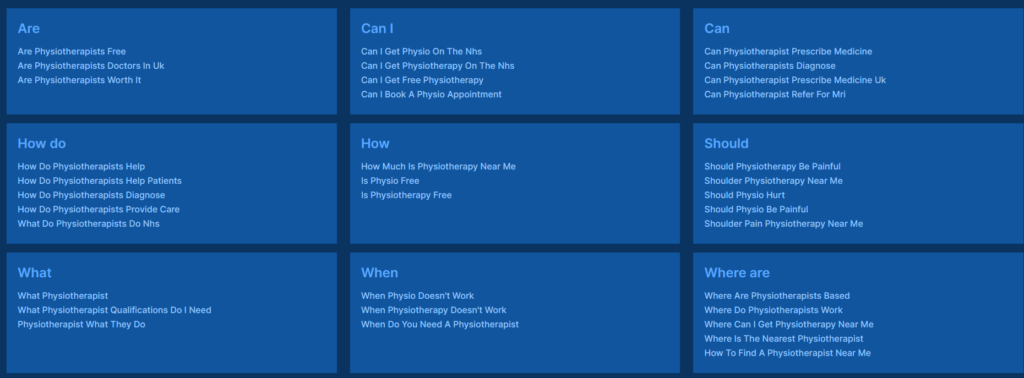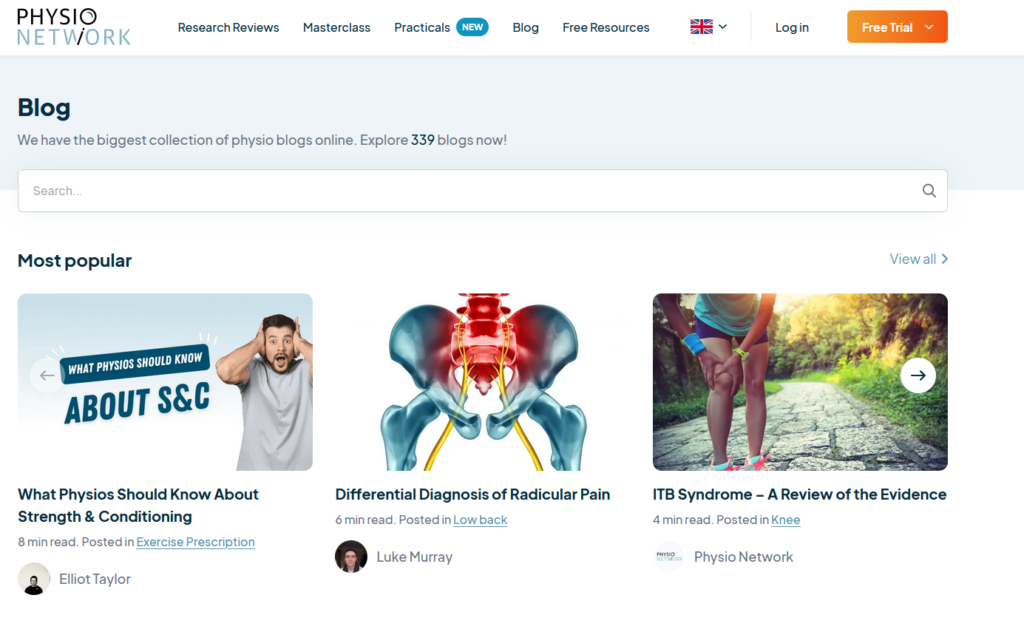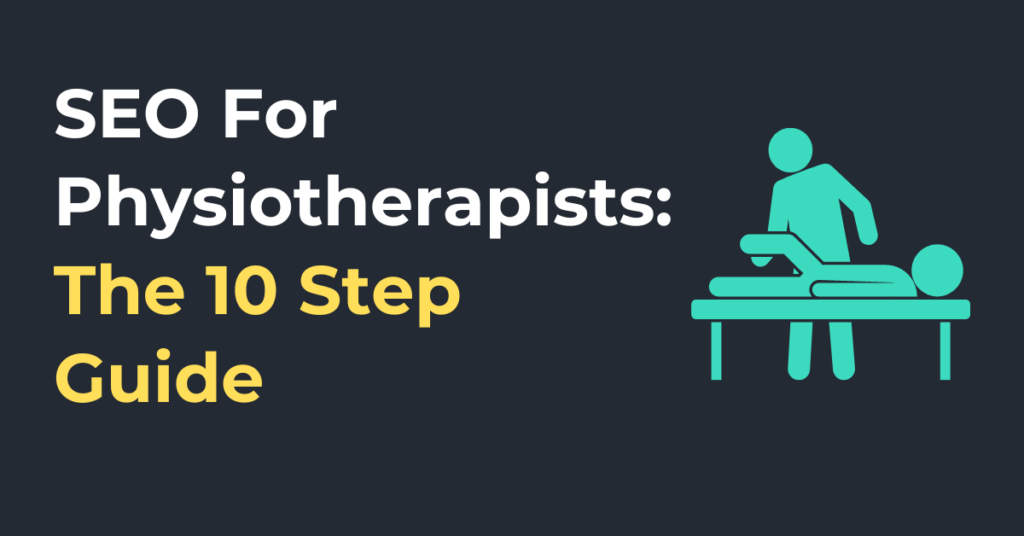1. Incorporate Local SEO Strategies
The Power of Local SEO

Local SEO is like setting up signposts in your town that lead directly to your physiotherapy practice. It’s about making sure that when someone in your area searches for physiotherapy services, your practice shows up at the top of the search results.
For example, if you’re based in New York and someone searches for “physiotherapists in New York,” you want your practice to be among the first they see. This is where local SEO comes into play.
How to Optimize for Local Search
- Use Location-Specific Keywords: Think of keywords as the terms people type into Google when looking for your services. Location-specific keywords include your city or area name. For example, “physiotherapy in New York” or “back pain treatment in Brooklyn.”
- Create Location-Centric Content: Write content that speaks to local events, news, or activities related to physiotherapy. If there’s a local marathon, you could write about exercises to prepare or recover from it.
- Optimize Your Google Business Profile: This is your business listing on Google. Make sure it includes accurate information like your address, phone number, and services. It’s like your business card on Google.
- Link to Your SEO Services Page: If you want to know more about how SEO can help your practice grow, check out our SEO services. It’s tailored to meet the needs of healthcare professionals like you.
Why Local SEO Matters
Local SEO is not just a buzzword; it’s a vital tool to attract more potential clients from your area. It puts your practice on the local map, making it easier for patients to find you on web searches. Imagine if your practice was the go-to place for physiotherapy in your town. That’s the power of local SEO.
By optimizing your website for local search, you’re not just promoting your services; you’re connecting with the community and building trust. It’s like being a friendly neighbor who’s always there to help.
2. Utilize Reviews for SEO
Embrace the Digital Word of Mouth

In today’s digital age, reviews are the new word of mouth. Just as a satisfied patient might tell their friends about your excellent service, they might also leave a glowing review online. These digital testimonials are essential for your physical therapy practice.
How Reviews Impact Your SEO
- Quality and Quantity Matter: More positive reviews can boost your SEO ranking. It’s like having many satisfied patients vouching for your services online.
- Real-Time Feedback with Tools: Platforms like Podium Reviews allow you to manage and optimize your online reviews. It’s like having a digital receptionist who gathers feedback from patients.
- Enhance Your Online Reputation: Good reviews make your practice look reliable and effective. It’s like having a wall full of thank-you notes from patients.
How to Encourage Reviews
- Ask for Them: After a successful treatment, kindly ask your patients if they would leave a review. It’s like asking for a referral but online.
- Respond to Reviews: Whether positive or negative, respond to reviews. Thank your patients for their kind words or address any concerns. It shows you care.
- Use Tools to Manage Reviews: Platforms like Podium can help you earn more positive reviews and respond to feedback in real time. It’s like having an assistant dedicated to patient satisfaction.
Reviews are more than just stars and comments; they’re a reflection of your practice’s quality, reliability, and effectiveness.
By managing them well, you can enhance your online reputation and draw in new patients.
Furthermore, by incorporating reviews into your SEO strategy, you’re not only improving your online presence but also connecting with your patients on a deeper level. It’s a win-win for your practice and your patients.
3. Optimize Site Speed

The Importance of a Fast Website
In the fast-paced world of the internet, time is of the essence. If your website takes too long to load, potential patients might click away before they even read about your services.
Therefore, optimizing your site’s speed is crucial.
How Site Speed Influences User Experience
Firstly, consider how quickly your website loads. It can significantly influence your bounce rate, which is the percentage of visitors who navigate away after viewing only one page.
A site that takes too long to load might lead potential patients to click away, losing you a potential appointment.
Moreover, studies show that a delay of even one second can lead to a 7% decrease in conversions. Hence, improving your site’s speed can directly lead to an increase in patient bookings.
It’s not just about the numbers; it’s about providing a smooth and enjoyable experience for your visitors.
Strategies to Enhance Site Speed
To tackle this issue, you can take several steps:
- Optimize Images: Large images can slow down your site. By compressing them, you can make your pages load faster without losing quality.
- Use Efficient Coding: Clean and efficient coding can make a significant difference in loading times. If coding isn’t your forte, consider hiring a professional to streamline your site.
- Consider a Content Delivery Network (CDN): CDNs can distribute the load, saving bandwidth and speeding up access for your users.
Connecting with Patients Through Speed
In conclusion, optimizing your site’s speed is not just a technical task; it’s a way to connect with your patients.
By providing a fast and efficient website, you show that you value their time and want to provide the best experience possible.
Whether it’s booking an appointment or reading about your services, a fast website makes everything more enjoyable. It’s a small detail that can make a big difference in how potential patients perceive your practice.
4. Mobile-Friendly Design

With the majority of people using smartphones today, it’s critical for your website to be optimized for mobile use.
A mobile-responsive site not only improves your ranking on search engines but also improves user experience.
Why Mobile Optimization Matters
People are often on the go. They might look up your services while waiting for a bus or during a lunch break.
If your website doesn’t look good on a mobile device, they might leave. It’s as simple as that.
How to Create a Mobile-Friendly Website
First, test your website on different devices. See how it looks on a phone, tablet, and desktop.
If it’s not responsive, consider updating the design. Many website platforms offer mobile-friendly templates.
Enhance User Experience with Mobile Design
A site optimized for mobile allows potential patients to access your information quickly and efficiently. This contributes positively to their overall user experience.
They can easily read about your services, book an appointment, or find your contact information. Everything is at their fingertips.
5. Use Relevant Keywords

Keywords are like the signposts of the internet. They guide search engines to your website.
The Role of Keywords
When people search for physiotherapy services, they use specific terms. These are your keywords.
Your website needs to include these terms. That way, search engines know to show your site to people looking for your services.
Examples of Potential Keywords
- Physiotherapy in [Your City]
- Back pain treatment
- Sports injury rehabilitation
- Post-surgery physiotherapy
How to Incorporate Keywords
Use these terms naturally in your content. Don’t overdo it.
Include them in headings, body text, and meta descriptions. Think of them as the key to unlocking more traffic to your site.
6. Commit to a Blog

A blog is like a continuous conversation with your patients. It keeps them engaged and coming back for more.
Why Blogging Matters
Blogs provide fresh, relevant content. Search engines love that.
They also position you as an expert. Patients trust experts.
What to Blog About
- Tips for home exercises
- How to prevent common injuries
- Success stories from your patients
- The importance of regular physiotherapy
Connecting Through Content
A blog isn’t just a marketing tool. It’s a way to connect with your patients.
Share your knowledge. Help them even when they’re not in your office.
7. Create a Secure (HTTPS) Website

Security is paramount in today’s digital world. Your website must be secure.
Why HTTPS Matters
HTTPS encrypts information. It keeps patient data safe.
Search engines favor secure sites. It boosts your SEO ranking.
How to Switch to HTTPS
Contact your hosting provider. They can help you make the switch.
Or hire a professional. They can ensure the transition is smooth.
Building Trust Through Security
A secure website builds trust. Patients know their information is safe with you.
It’s not just a technical detail. It’s a patient care detail.
8. Foster Backlinking

Backlinks are like digital handshakes. They connect your website to others.
The Role of Backlinks
When another site links to yours, search engines take notice. It’s like a vote of confidence.
The more quality backlinks you have, the higher your site ranks.
Strategies to Create Shareable Content
- Write informative blog posts
- Create engaging videos
- Offer free resources like ebooks or guides
Collaborate with other healthcare professionals. Share each other’s content.
Building Relationships Through Backlinks
Backlinking isn’t just about SEO. It’s about building relationships.
Connect with others in your field. Grow together.
9. Optimize Meta Descriptions

Meta descriptions are like digital billboards. They advertise your content.
What Are Meta Descriptions?
They’re short summaries of your web pages. Search engines display them in search results.
A compelling meta description can increase your click-through rate.
How to Write Effective Meta Descriptions
- Include your main keyword
- Keep it under 160 characters
- Make it engaging
Think of it as a mini-ad for your page.
Meta Descriptions and SEO
Meta descriptions don’t directly affect SEO. But they do affect clicks.
More clicks can mean higher rankings. It’s all connected.
10. Utilize SEO Auditing Tools

SEO isn’t a one-time task. It’s ongoing.
Importance of Continuous SEO Monitoring
Search engines change their algorithms. You must keep up.
Regularly auditing your SEO ensures you stay on top.
Tools for Identifying Gaps
- Google Analytics
- SERanking
- Moz
- SEMrush
These tools show you what’s working and what’s not.
Stay Ahead with SEO Auditing
SEO auditing isn’t just about numbers. It’s about staying ahead.
Keep your website performing well. Keep attracting new patients.
It’s a continuous effort. But it’s worth it.
TL;DR
- Local SEO: Be the go-to physiotherapist in your area.
- Reviews: Boost your online reputation with positive feedback.
- Site Speed: Keep your website fast and user-friendly.
- Mobile Design: Meet your patients where they are – on their phones.
- Keywords: Use the right terms to attract the right patients.
- Blogging: Connect with your patients through regular content.
- HTTPS: Keep patient information safe and build trust.
- Backlinking: Build relationships and boost your ranking.
- Meta Descriptions: Advertise your content effectively.
- SEO Auditing: Stay on top of your game with regular check-ups.
In a nutshell, SEO for physiotherapists is about more than just technical details. It’s about connecting with your patients, building trust, and providing a seamless online experience. Whether it’s through keywords, blogging, or mobile optimization, every aspect of SEO can help you grow your practice and care for your patients even when they’re not in your office. It’s a digital extension of your care.


